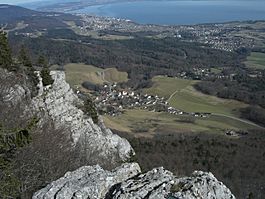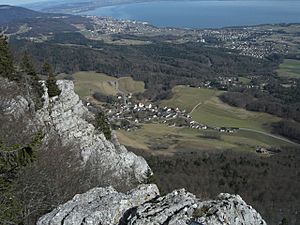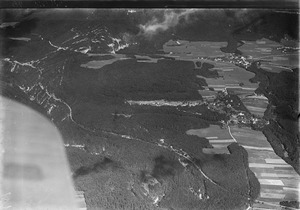Rochefort, Neuchâtel facts for kids
Quick facts for kids
Rochefort
|
||
|---|---|---|
 |
||
|
||
| Country | Switzerland | |
| Canton | Neuchâtel | |
| Area | ||
| • Total | 25.85 km2 (9.98 sq mi) | |
| Elevation | 759 m (2,490 ft) | |
| Population
(Dec 2020 )
|
||
| • Total | 1,291 | |
| • Density | 49.942/km2 (129.35/sq mi) | |
| Postal code |
2019
|
|
| Surrounded by | Boudry, Brot-Plamboz, Corcelles-Cormondrèche, La Sagne, Milvignes, Montmollin | |
Rochefort is a town in Switzerland. It is located in the canton of Neuchâtel. A canton is like a state or region in Switzerland.
On January 1, 2016, a smaller town called Brot-Dessous became part of Rochefort.
Contents
Exploring Rochefort's Past
Rochefort has a long history. It was first mentioned in old writings in 1184. Back then, it was called Rupeforti. Later, in 1236, its name was written as Rochifort.
Discovering Rochefort's Geography
Rochefort is a good-sized town. It covers about 20.9 square kilometers (about 8 square miles). A large part of this land is covered by forests, about 62.5%. Another big part, about 32.4%, is used for farming. The rest of the land has buildings, roads, or is not used for anything.
The town is located where two important roads meet. These roads connect Colombier to Le Locle and Neuchâtel to Pontarlier. Rochefort includes several smaller areas. These are Rochefort, Montézillon, Chambrelien, Les Grattes, La Tourne, and Crostand.
Understanding Rochefort's Coat of Arms
Every town has a special symbol called a coat of arms. Rochefort's coat of arms has four sections, colored gold and red. It also has a black border with eight gold circles on it.
Rochefort's Population and People
Rochefort has a population of about 1,035 people. Some people living here are from other countries. Over the past ten years, the number of people living in Rochefort has grown by about 11.7%. Most of this growth is from people moving to the town.
Most people in Rochefort speak French. About 87.7% of the population uses French as their main language. The next most common language is German, spoken by about 5.4% of the people. A small number of people also speak English or Italian.
In 2008, about half of the people in Rochefort were male and half were female. About 25% of the population were children and teenagers (under 19 years old). Adults (aged 20-64) made up about 62% of the population. Older adults (over 64) made up about 13%.
Many people in Rochefort were born in the town or in the same canton. About 11.5% of the people were born outside of Switzerland.
Here is a chart showing how Rochefort's population has changed over time:

Important Historical Sites in Rochefort
Rochefort has a special place called Cotencher. It is a paleolithic cave. This means it's a very old cave where people lived long, long ago. It is listed as a very important historical site in Switzerland.
Rochefort's Economy and Jobs
In 2010, the unemployment rate in Rochefort was 2.8%. This means only a small number of people who wanted jobs couldn't find them.
Many people in Rochefort have jobs. Some work in farming or forestry. Others work in factories or construction. A lot of people also work in the "tertiary sector." This includes jobs like sales, transportation, hotels, restaurants, and healthcare.
Many people who live in Rochefort travel to other towns for work. About 6.8 workers leave Rochefort for every one worker who comes into the town for a job. Most people use a private car to get to work. About 9.8% use public transportation.
Religion in Rochefort
In 2000, about 17.7% of the people in Rochefort were Roman Catholic. About 46.7% belonged to the Swiss Reformed Church. Some people belonged to other Christian churches. A small number of people were Islamic. About 22.1% of the people said they did not belong to any church.
Education in Rochefort
Education is important in Rochefort. About 36.3% of the people have finished high school. About 16.9% have gone on to get a higher education, like from a university.
In the canton of Neuchâtel, children usually go to two years of kindergarten. Then they have five years of primary school. After that, they go to secondary school for four years. Many students travel to larger schools outside of Rochefort for secondary education.
Rochefort shares its kindergarten and primary school with the nearby town of Brot-Dessous. In the 2010-2011 school year, there was one kindergarten class with 16 students. There were also three primary classes with 61 students.
Transportation in Rochefort
Rochefort has good transportation options. It has two railway stations: Champ-du-Moulin and Chambrelien. These stations connect Rochefort to other towns. You can easily travel by train to places like La Chaux-de-Fonds, Buttes, and Neuchâtel.
See also
 In Spanish: Rochefort (Neuchâtel) para niños
In Spanish: Rochefort (Neuchâtel) para niños






